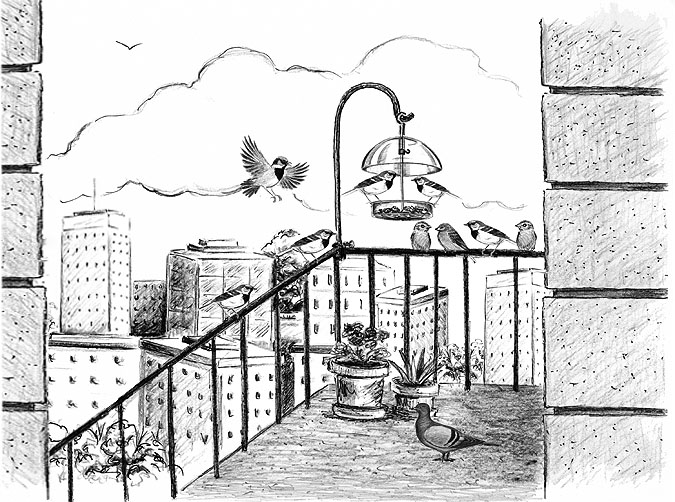
Dear Bird Folks,
I live in a fairly urban environment that’s just outside of Boston. We have a bird feeder that the local sparrows love. Unfortunately, they are the only birds we get. If our yard can attract so many sparrows, why doesn’t it attract other birds as well?
– Amy, Somerville, MA
Not Somerville, Amy,
No offense, but I had a wicked disappointing experiences in Somerville. A few years ago I saw poster announcing “The Annual Somerville Honk! Festival.” The Honk! Festival??? While the poster didn’t explain what the Honk! Festival was, I readily assumed it’s a festival held to honor Canada Geese. Great! It was about time a community had an event to show appreciation for these much maligned birds. Of course, I had to go. On the day of the festival I arrived early, proudly wearing my “I love a good goose” T-shirt. That’s when I found out that the day had nothing to do with birds. It seems the Honk! Festival is about street musicians. The “honk” refers to people playing horns, and other instruments. Are they kidding? No geese? Who ever heard of a festival being about music? It was one of the biggest disappointments of my life…well, until the 2011 Red Sox.
In many cities the three most common birds are Rock Pigeons (aka pigeons), European Starlings and your friends, House Sparrows. All three of these birds have one thing in common: They are all non-native, just like most of us. These foreign birds were brought to this continent because some Europeans wanted the New World to be like the place they had just left. For some reason, the birds that were already here weren’t good enough for them. (It’s like the people who move to Cape Cod, dig up the native vegetation and replace it with a high maintenance suburban lawn.) Many other species were also introduced, but most of them couldn’t hack it and failed to generate a sustainable population. But pigeons, starlings and sparrows are amazingly adaptable birds and they thrived in the New World.
Historically, Rock Pigeons nested on cliffs and rock ledges (hence their name). Over the centuries pigeons have slowly substituted building ledges and bridge girders for rock ledges. Sparrows and starlings, on the other hand, like to build their nests in holes, any kind of holes. It really doesn’t make a difference to them if the holes are in a tree trunk or a CVS sign. Since there are thousands of artificial nesting holes in every city, these birds found it easier to live in town rather than commute from the suburbs. In addition to having an abundance of nesting locations, cities offer an array of food choices. When the House Sparrows first arrived here in the mid-1800s, our streets were literally paved with food. Back then horses were the primary source of transportation. The sparrows readily gobbled up all the leftover grain spilled by the sloppy horses. The birds were also clever enough to pick out the undigested seeds from the ever-present horse manure. (You know a bird is adaptable when it isn’t too grossed out to search for food in a steaming pile of manure.) When automobiles replaced horses, the birds quickly shifted gear and started consuming food that was dropped by a species that is even sloppier than horses…humans.
Right now you must be thinking, “If the cities are so bountiful, why don’t the native birds take advantage of them, too?” (Actually, Amy, I think that was your original question.) Adapting to environmental changes takes time. The pigeons, starlings and sparrows had already learned how to deal with European cities long before they were transported here. So when they arrived, they were already pre-adapted (if there is such a word). The destruction of habitat and the craziness of civilization were too much for the native birds. Most of them took the trolley to the end of the line and kept going. This is not to say that a few cardinals, chickadees, finches, etc. aren’t seen in cities. They certainly are, but the lack of proper nesting sites and natural food sources makes it tough for native birds to flourish. Plus, they have trouble competing with the more aggressive city birds. (You know how pushy those city types can be.)
In addition to being more aggressive and more adaptable, city birds have something else going for them. They may actually be more smaterer. A recent study has found that city birds, with their ability to avoid canyons of glass buildings, herds of rushing pedestrians and rabid cab drivers, actually have larger brains than their country cousins. How about that! I’m not surprised, though. City birds should be smarter since they are surrounded by the best colleges, universities and art museums. In fact, pigeons love art so much that they make regular “contributions” to every statue they can find.
While pigeons, starlings and sparrows are the urban avian kings right now, it doesn’t mean that’s the way it will stay. As I said earlier, adapting to environmental changes takes time. We’ve already seen falcons and hawks nesting on urban high-rises. I wouldn’t be surprised if more native species followed their lead. And speaking of surprises, I plan to return to Somerville to attend this year’s Honk! Festival. Maybe I’ll see you there, Amy. Just keep in mind that I’ll be wearing my “I love a good goose” T-shirt again, so please don’t wear yours, too. That would be awkward.